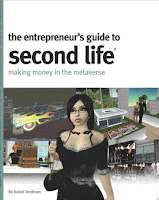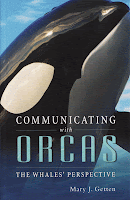 The Entrepreneur's Guide to Second Life: Making Money in the Metaverse by Daniel Terdiman (Wiley Publishing, 2007, ISBN 978-0-470-17914-7)
The Entrepreneur's Guide to Second Life: Making Money in the Metaverse by Daniel Terdiman (Wiley Publishing, 2007, ISBN 978-0-470-17914-7)
This book was written by: Daniel Terdiman, a journalist and second life enthusiast. It was a bold step for Mr. Terdiman to write a book about making money in a world where "economic activity is conducted in a make-believe currency which, though it can be directly converted to hard currency, is definitely not legal tender"(p.10), especially considering his declaration that "I've never been a successful Second Life entrepreneur." But you don't have to be a successful parent to tell other people how to raise their kids.
What is in this book: A guide to the business side of Second Life, an online computer environment that is "not a game. After all, it doesn't have a goal"(p.141), but it does have "very visible subcommunities whose members walk around chained to each other or dressed like dragons or who may be having sex in a public place"(p.143). Mr. Terdiman walks readers through some of the largest market segments in this world that is "beset by seemingly never-ending bugs, crashes, rolling restarts, user-interface problems, and many other issues"(p.264), discussing the resources available and skills needed for entrepreneurs looking to start businesses in some of the most popular industries catering to Second Life residents—including the sex industry.
While there is a rule prohibiting "'age play,' defined somewhat broadly as sexual behavior between two or more residents in which at least one is using what appears to be a child avatar and the other is using an adult avatar"(p.162), (which means that everything Law & Order: SVU taught me WAS A LIE), there is detailed information on other opportunities in the adult services industry including sex fasion, sex clubs, sex animations, and sex furniture. For example, "escorts can earn from US$3 to US$14 in an hour. Again, over time, and with volume, it adds up pretty quickly"(p.17), or you can sell "a wide range of penises and vaginas in various sizes and levels of functionality and complexity"(p.165), and "there's also fashion for all kinds of specific subcommunities, like furries"(p.16).
Other chapters cover topics such land sales and construction, but they don't have phrases like "people whose job it is to manage the escorts,"(p.166) which is nicest way of writing "pimps"(p.167) that I have ever seen.
 What is not in this book: Instructions on how to get rich by teaching people how to make money in Second Life. That's a shame, since telling people to come up with new ideas sounds a lot easier than coming up with the ideas themselves, especially when considering the market's relaxed attitude towards intellectual property laws—as illustrated by Terdiman himself. "As a small, relatively unknown DJ in Second Life, you could probably get away with not paying royalties because you almost certainly wouldn't get caught"(p.214). It's equally tough to catch people stealing from you, "in much the same way that a store in real life could be broken into. The best defense? Keep coming up with ideas"(p.19), which you have to do anyway because "you have to find ways to make your business and your products or services stand out"(p.68). In a world where public dragon sex is the norm, you've got to take it one step further. "If all you do is create a new kind of sex bed, you're just one more entrant in the vast sex-bed market, and you'll find it that much harder to set yourself apart"(p.181).
What is not in this book: Instructions on how to get rich by teaching people how to make money in Second Life. That's a shame, since telling people to come up with new ideas sounds a lot easier than coming up with the ideas themselves, especially when considering the market's relaxed attitude towards intellectual property laws—as illustrated by Terdiman himself. "As a small, relatively unknown DJ in Second Life, you could probably get away with not paying royalties because you almost certainly wouldn't get caught"(p.214). It's equally tough to catch people stealing from you, "in much the same way that a store in real life could be broken into. The best defense? Keep coming up with ideas"(p.19), which you have to do anyway because "you have to find ways to make your business and your products or services stand out"(p.68). In a world where public dragon sex is the norm, you've got to take it one step further. "If all you do is create a new kind of sex bed, you're just one more entrant in the vast sex-bed market, and you'll find it that much harder to set yourself apart"(p.181).
Would you recommend this book to P.T. Barnum? Yes, because there's a sucker born Second Life resident signed up every minute, despite the fact that "Second Life uses a huge amount of your computing power, and even in the best-case scenario, with the fastest computer, the most memory, the fattest Internet pipe, and so forth, you're still looking at software that is waiting for hardware to catch up"(p.22). Considering these new arrivals, "some might worry that so many extra people coming into the virtual world might erode the opportunities to make money, but I see the reality as just the opposite: the more people there are, the more potential customers"(p.iv).
Would you recommend this book to John Smith? Yes. I know he's upset that he won't gain notoriety through his financial exploits because his name is not a distinctive one, like Branson, Murdoch, or Trump, but Second Life will let him use a new name that more clearly reflects his business acumen. He can follow the examples set by Second Life heavyweights such as Munchflower Zauis (p.73), Wynx Whiplash (p.199), Fallingwater Cellardoor (p.75), Alphazero Sugar (p.189), and Stroker Serpentine (p.171). In fact, I'm starting a business with my avatar, Weeaboo Hazington XIV. I expect great things from him.
What was interesting about this book? No discussion of the Second Life financial landscape would be complete without mentioning the scandal that ensued when some of the largest Second Life banks were exposed as Ponzi schemes, triggering Linden Lab to impose a ban on all virtual banks. While the book's publication schedule made it difficult to include that information, Mr. Terdiman points out that "some would say that Second Life's economy is actually more stable than that of any new country"(p.4), an argument that has merit when you consider that the "F" rating from the Better Business Bureau was actually given to Linden Lab and not to Second Life itself.
These days, "there is great opportunity for new businesses, and for more people to make money in Second Life than ever before"(p.264), even in a tough economic climate. Every large Second Life–based business that fails spectacularly is good news for new entrepreneurs, because it means someone else can step in to fill the niche. "Indeed, nearly everywhere you turn in Second Life there are signs of the strength of the economy: stores of all kinds are ubiquitous, the number of private sims is skyrocketing, and week in and week out, residents of the virtual world are trading millions of US dollars' worth of goods"(p.264).







